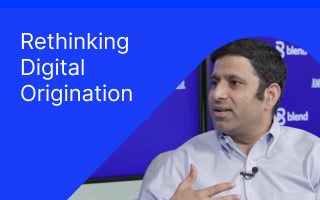March 10, 2021 in Challenges and solutions
How Blend helps financial institutions transform their tech stack
For the tech teams: improving and innovating your front end is no longer enough. Explore a more holistic approach to modernizing your organization’s technology architecture.

The ways consumers shop, communicate, and interact with brands have changed dramatically — even over the past year — and lending is no different. 50% of consumers now interact with their bank through mobile apps or websites at least once a week, compared to 32% two years ago. For some financial institutions, this has been a call to action: get a digital change strategy in place, and quickly. For others, recent events have functioned as an accelerator for ongoing digital transformation.
No matter which camp they may be in, lenders adapting their operating model are seeking new ways to reduce costs, reinvent processes, and keep pace with goals. While shifting consumer trends may feel like a stressful addition to lenders’ ongoing technology endeavors, we believe now is the best time to transform your tech stack.
It’s time to think about a holistic, integrated approach to the technology powering your bank. While financial institutions may have felt forced to choose between satisfying consumer needs and building a more efficient internal system, this is no longer the case. Solutions like Blend support better digital lending development while improving the experience for both consumers and lending teams.
Thinking about the big picture: Your system of systems
Some financial institutions are working with technology systems that were designed over 40 years ago with more and more solutions layered on top of legacy systems. The result can be a rapidly growing set of technology systems that is increasingly difficult to manage, innovate on, and integrate with new products.
While it may seem smarter to tackle one layer or channel at a time — say, fixing the consumer UX — we believe the path to sustainable innovation with strong ROI requires a more holistic approach.
Tech teams can take a step back and think about their overall system of systems. This larger view encompasses the tools, processes, data, and integrations that collectively delivers value greater than the sum of its parts. Are you providing the value that you need to provide for consumers and your colleagues in branches, call centers, and the office?
The challenges of modernizing a financial institution’s tech stack
We understand that tech teams are facing a lot of pressure to solve current problems while also innovating for the future. The strides tech leaders have made in the past year are not only noteworthy, but they’re also helping banks thrive in today’s economic climate. Here are a few of the common challenges we are seeing in the lending industry:
Solving problems with quick fixes and a short-sighted approach
Some financial institutions have adapted by continuously adding new solutions and systems with a daisy chained series of integrations. When lenders don’t make decisions with consideration for the full ecosystem, issues can pile up and compound over time.
Over-prioritizing improvements for the front end
According to Forrester Consulting’s milestone-based lending report, the vast majority of digital transformation initiatives have not yet met their goals. This may be due to organizations prioritizing front end improvements, which can result in overlooking the innovation opportunities found in deeper sections of the tech stack. Even though those areas may not be directly consumer facing, they can improve the overall consumer experience when addressed properly. For example, creating a single, unified customer data model translates into stronger customer insights and seamless service across lines of business.
Building in silos and replicating solutions
LOBs often require a common set of solutions, but tech teams may tackle each product individually and build in silos. In most cases, the majority of innovation can be shared. For example, verifying income is critical in the lending process, but there may not always be a need to rebuild or replicate a solution for income verification across LOBs. A siloed approach makes it difficult for financial institutions to maintain data, services, and business workflows across systems, while also prioritizing investments against requirements and keeping stakeholders satisfied.
How Blend’s Digital Lending Platform supports holistic innovation
Whether your organization is looking for an out-of-the-box solution or services like verification that can easily plug into your homegrown workflows, our platform has you covered. Our products cover many lines of business (including but not limited to: auto loans, personal loans, and mortgage), enabling organizations to get up and running quickly. Blend offers an advanced set of orchestration capabilities that allow tech teams to configure products for better cross-sell functionality, workflows, and decisioning — enabling experiences that align with the team’s long-term vision and requirements.
Not just the latest in technology advances
Subscribe for industry trends, product updates, and much more.
Our platform provides a set of underlying microservices — including VOA, VOI, and IDV — specifically designed for financial services. When tech teams can tap into our broad ecosystem of services, it enables them to quickly bring new products to market and minimizes consumer friction in the overall experience.
With a robust set of APIs, we support better digital lending development with a unified application experience, orchestration, data verifications, and integrations. Blend is built to play nice with your other systems. As tech teams modernize their technology systems, our platform provides flexible solutions and supports innovation throughout the lending lifecycle.
At Blend, we know the finish line is always moving as technology evolves. Enterprise architecture and innovation is perpetually a work in progress, but we are committed to supporting lenders with the latest solutions. Our Digital Lending Platform is flexible, adaptable, and innovative — a future-proof addition to your tech stack that better enables a modern system architecture.
Ready to see how Blend has transformed financial institutions around the country?
Find out what we're up to!
Subscribe to get Blend news, customer stories, events, and industry insights.


